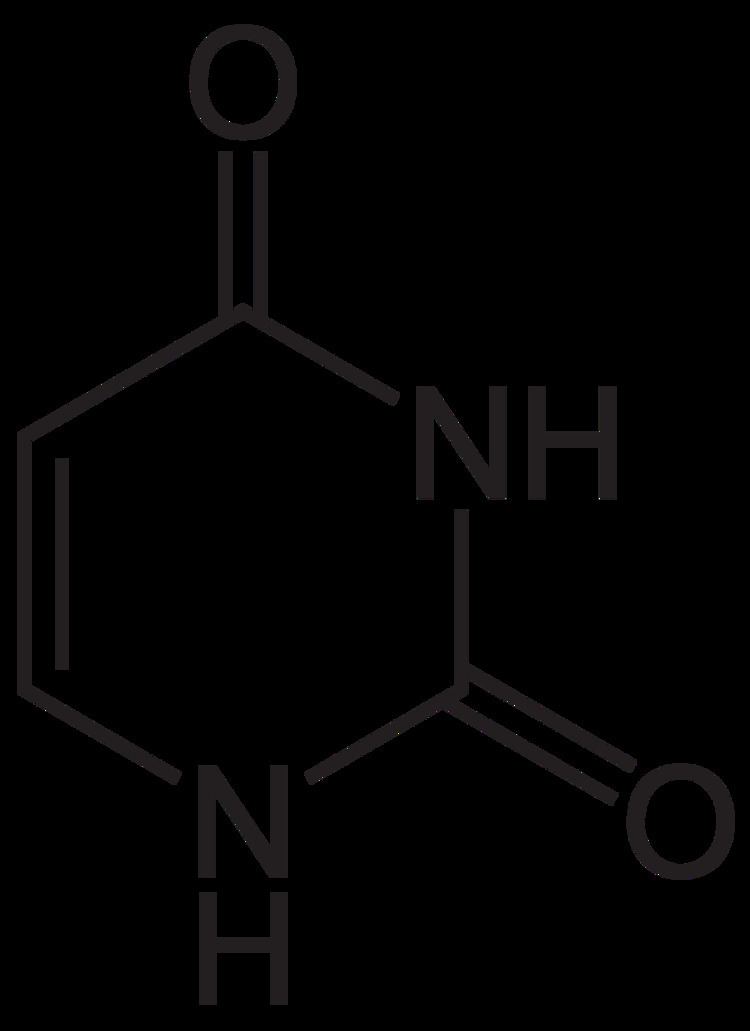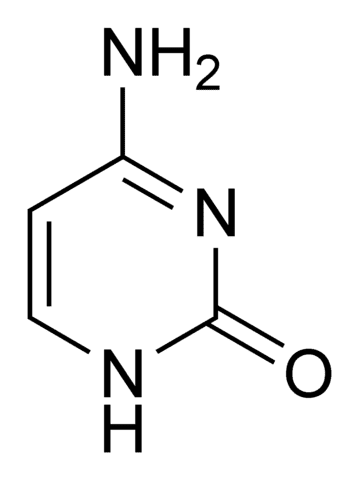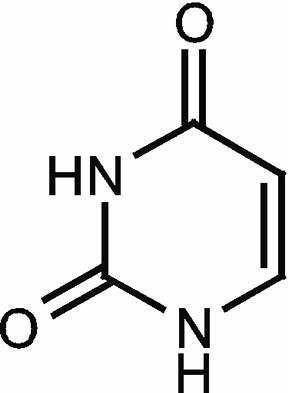Related compounds Molar mass 112.0868 g/mol Density 1.32 g/cm³ Appearance Solid | Formula C4H4N2O2 Melting point 335 °C Soluble in Water | |
 | ||
IUPAC ID Pyrimidine-2,4(1H,3H)-dione | ||
Uracil chemistry
Uracil /ˈjʊərəsɪl/ (U) is one of the four nucleobases in the nucleic acid of RNA that are represented by the letters A, G, C and U. The others are adenine (A), cytosine (C), and guanine (G). In RNA, uracil binds to adenine via two hydrogen bonds. In DNA, the uracil nucleobase is replaced by thymine. Uracil is a demethylated form of thymine.
Contents

Uracil is a common and naturally occurring pyrimidine derivative. The name "uracil" was coined in 1885 by the German chemist Robert Behrend, who was attempting to synthesize derivatives of uric acid. Originally discovered in 1900 by Alberto Ascoli, it was isolated by hydrolysis of yeast nuclein; it was also found in bovine thymus and spleen, herring sperm, and wheat germ. It is a planar, unsaturated compound that has the ability to absorb light.

Based on 12C/13C isotopic ratios of organic compounds found in the Murchison meteorite, it is believed that uracil, xanthine and related molecules can also be formed extraterrestrially.

In 2012, an analysis of data from the Cassini mission orbiting in the Saturn system showed that Titan's surface composition may include uracil.
Properties
In RNA, uracil base-pairs with adenine and replaces thymine during DNA transcription. Methylation of uracil produces thymine. In DNA, the evolutionary substitution of thymine for uracil may have increased DNA stability and improved the efficiency of DNA replication (discussed below). Uracil pairs with adenine through hydrogen bonding. When base pairing with adenine, uracil acts as both a hydrogen bond acceptor and a hydrogen bond donor. In RNA, uracil binds with a ribose sugar to form the ribonucleoside uridine. When a phosphate attaches to uridine, uridine 5'-monophosphate is produced.
Uracil undergoes amide-imidic acid tautomeric shifts because any nuclear instability the molecule may have from the lack of formal aromaticity is compensated by the cyclic-amidic stability. The amide tautomer is referred to as the lactam structure, while the imidic acid tautomer is referred to as the lactim structure. These tautomeric forms are predominant at pH 7. The lactam structure is the most common form of uracil.
Uracil also recycles itself to form nucleotides by undergoing a series of phosphoribosyltransferase reactions. Degradation of uracil produces the substrates aspartate, carbon dioxide, and ammonia.
C4H4N2O2 → H3NCH2CH2COO− + NH4+ + CO2Oxidative degradation of uracil produces urea and maleic acid in the presence of H2O2 and Fe2+ or in the presence of diatomic oxygen and Fe2+.
Uracil is a weak acid. The first site of ionization of uracil is not known. The negative charge is placed on the oxygen anion and produces a pKa of less than or equal to 12. The basic pKa = -3.4, while the acidic pKa = 9.389. In the gas phase, uracil has 4 sites that are more acidic than water.
In DNA
Uracil is rarely found in DNA, and this may have been an evolutionary change to increase genetic stability. This is because cytosine can deaminate spontaneously to produce uracil through hydrolytic deamination. Therefore, if there was an organism that used uracil in DNA, the deamination of cytosine (which undergoes base pairing with guanine) would lead to formation of uracil (which would base pair with adenine) during DNA synthesis. Uracil-DNA glycosylase excises uracil bases from double-stranded DNA. This enzyme would therefore recognize and cut out both types of uracil - the one incorporated naturally and the one formed due to cytosine deamination, which would lead to unnecessary and inappropriate repair processes.
This problem is believed to have been solved in terms of evolution, i.e. by "tagging" (methylating) uracil. Methylated uracil is identical to thymine. Therefore, it is hypothesized that over time thymine became the DNA standard instead of uracil. Therefore, cells now use uracil in RNA and not in DNA because RNA is more short-lived than DNA and any potential uracil-related errors do not lead to any lasting damage. Apparently, there was no evolutionary pressure to replace uracil with the more complex thymine in RNA. Uracil-containing DNA still exists, for example in
Synthesis
In a scholarly article published in October 2009, NASA scientists reported having reproduced uracil from pyrimidine by exposing it to ultraviolet light under space-like conditions. This suggests that one possible natural original source for uracil in the RNA world could have been panspermia. More recently, in March 2015, NASA scientists reported that, for the first time, additional complex DNA and RNA organic compounds of life, including uracil, cytosine and thymine, have been formed in the laboratory under outer space conditions, using starting chemicals, such as pyrimidine, found in meteorites. Pyrimidine, like polycyclic aromatic hydrocarbons (PAHs), the most carbon-rich chemical found in the Universe, may have been formed in red giants or in interstellar dust and gas clouds, according to the scientists.
There are many laboratory syntheses of uracil available. The first reaction is the simplest of the syntheses, by adding water to cytosine to produce uracil and ammonia. The most common way to synthesize uracil is by the condensation of malic acid with urea in fuming sulfuric acid as seen below also. Uracil can also be synthesized by a double decomposition of thiouracil in aqueous chloroacetic acid.
C4H5N3O + H2O → C4H4N2O2 + NH3COOH(CH2)2COOH + NH2CONH2 → C4H4N2O2 + 2 H2O + COPhotodehydrogenation of 5,6-diuracil, which is synthesized by beta-alanine reacting with urea, produces uracil.
Reactions
Uracil readily undergoes regular reactions including oxidation, nitration, and alkylation. While in the presence of phenol (PhOH) and sodium hypochlorite (NaOCl), uracil can be visualized in ultraviolet light. Uracil also has the capability to react with elemental halogens because of the presence of more than one strongly electron donating group.
Uracil readily undergoes addition to ribose sugars and phosphates to partake in synthesis and further reactions in the body. Uracil becomes uridine, uridine monophosphate (UMP), uridine diphosphate (UDP), uridine triphosphate (UTP), and uridine diphosphate glucose (UDP-glucose). Each one of these molecules is synthesized in the body and has specific functions.
When uracil reacts with anhydrous hydrazine, a first-order kinetic reaction occurs and the uracil ring opens up. If the pH of the reaction increases to >10.5, the uracil anion forms, making the reaction go much more slowly. The same slowing of the reaction occurs if the pH decreases, because of the protonation of the hydrazine. The reactivity of uracil remains unchanged, even if the temperature changes.
Uses
Uracil's use in the body is to help carry out the synthesis of many enzymes necessary for cell function through bonding with riboses and phosphates.Uracil serves as allosteric regulator and coenzyme for reactions in the human body and in plants. UMP controls the activity of carbamoyl phosphate synthetase and aspartate transcarbamoylase in plants, while UDP and UTP requlate CPSase II activity in animals. UDP-glucose regulates the conversion of glucose to galactose in the liver and other tissues in the process of carbohydrate metabolism. Uracil is also involved in the biosynthesis of polysaccharides and the transportation of sugars containing aldehydes. Uracil is important for the detoxification of many carcinogens, for instance those found in tobacco smoke Uracil is also required to detoxify many drugs such as cannabinoids(THC) and morphine(opioids) It can also slightly increase the risk for cancer in unusual cases in which the body is extremely deficient in folate. The deficiency in folate leads to increased ratio of deoxyuracilmonophosphates (dUMP)/deoxythyminemonophosphates (dTMP) and uracil misincorporation into DNA and eventually low production of DNA.
Uracil can be used for drug delivery and as a pharmaceutical. When elemental fluorine is reacted with uracil, 5-fluorouracil is produced. 5-Fluorouracil is an anticancer drug (antimetabolite) used to masquerade as uracil during the nucleic acid replication process. Because 5-Fluorouracil is similar in shape to, but does not undergo the same chemistry as, uracil, the drug inhibits RNA replication enzymes, thereby blocking RNA synthesis and stopping the growth of cancerous cells. Uracil can also be used in the synthesis of caffeine
Uracil can be used to determine microbial contamination of tomatoes. The presence of uracil indicates lactic acid bacteria contamination of the fruit. Uracil derivatives containing a diazine ring are used in pesticides. Uracil derivatives are more often used as antiphotosynthetic herbicides, destroying weeds in cotton, sugar beet, turnips, soya, peas, sunflower crops, vineyards, berry plantations, and orchards.
In yeast, uracil concentrations are inversely proportional to uracil permease.
